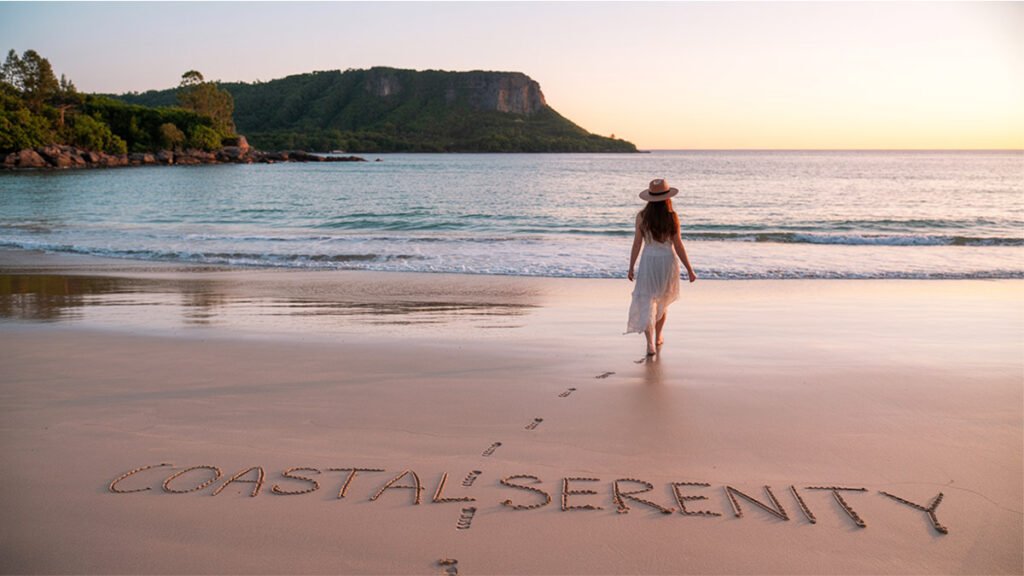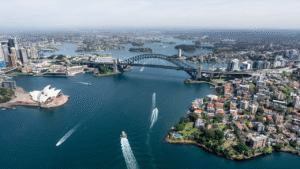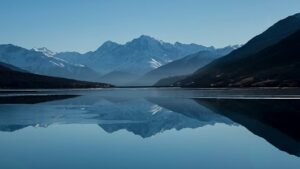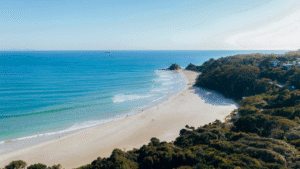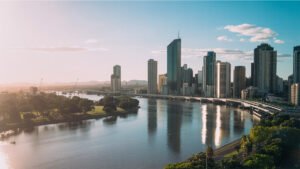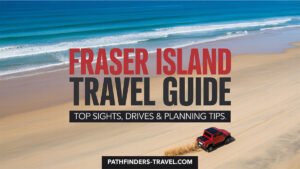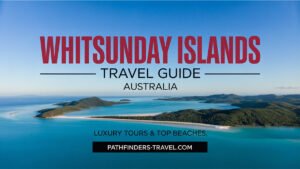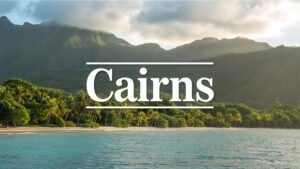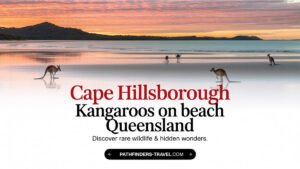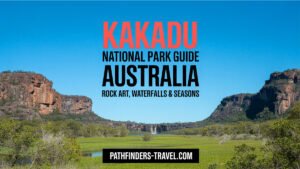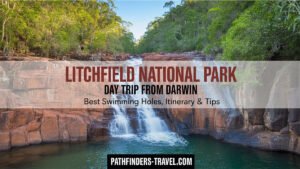Estimated reading time: 17 minutes
Key Takeaways
- The Sunshine Coast offers a laid-back atmosphere, with natural attractions like Noosa National Park and Glass House Mountains hiking trails, perfect for nature lovers and adventurers.
- The Gold Coast provides a vibrant urban beach experience with Surfers Paradise Beach and family attractions like Currumbin Wildlife Sanctuary
- Noosa National Park Coastal Walk spans 5.4 km each way with opportunities to spot wildlife and enjoy stunning ocean views
- Lamington National Park features spectacular waterfalls and rainforest trails for nature enthusiasts
- The best time to visit both coasts is during spring (September-November) and autumn (April-June) for ideal weather conditions
Table of Contents
- Introduction
- Top Sunshine Coast Attractions for Nature Lovers
- Gold Coast Attractions
- Comparative Analysis: Sunshine Coast vs. Gold Coast
- Practical Tips and Recommendations
- Conclusion
Introduction
Queensland stands as one of Australia’s premier coastal holiday destinations, renowned for its stunning beaches, verdant national parks, and vibrant coastal towns [SOURCE]. This sunshine coast travel guide will compare two of Queensland’s most beloved coastal regions: the Sunshine Coast and the Gold Coast. Whether you’re planning a family vacation, a romantic getaway, or a solo adventure, understanding the unique characteristics of these two spectacular areas will help you create the perfect Queensland coastal experience.
While both regions boast beautiful beaches and plenty of sunshine, they offer distinctly different atmospheres and attractions. The Sunshine Coast delivers a more relaxed, nature-focused experience, while the Gold Coast combines beach culture with urban energy and entertainment options. In this comprehensive guide, we’ll explore the highlights of both destinations to help you decide which best suits your travel style.
Want to see this for yourself? Click here to jump to the video in UHD 4K Resolution.
Top Sunshine Coast Attractions for Nature Lovers
Overview of the Sunshine Coast
The Sunshine Coast is celebrated for its laid-back atmosphere, stunning natural beauty, and relaxed coastal towns. Unlike its more commercialized neighbor to the south, this region emphasizes a connection with nature, providing visitors with tranquil beaches, scenic hiking trails, and charming waterfront communities [SOURCE]. The area stretches from Caloundra in the south to Noosa in the north, encompassing over 100 kilometers of pristine coastline.
What makes the Sunshine Coast particularly special is its balance of coastal relaxation and natural adventure. Here, you can start your day with a peaceful beach walk, spend the afternoon exploring lush hinterland villages, and end with a sunset meal at a waterfront restaurant. The region’s slower pace and focus on outdoor experiences create the perfect setting for travelers seeking rejuvenation and natural beauty.
Explore Noosa National Park Coastal Walk: A Guide to Scenic Trails and Wildlife
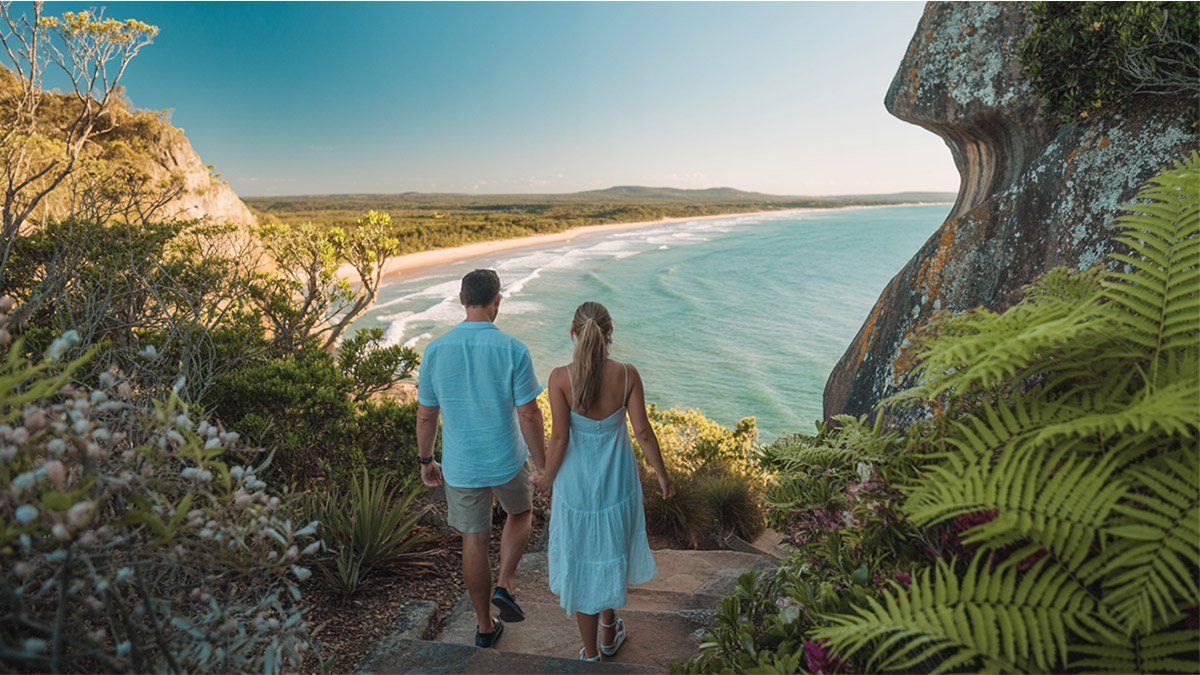
The Noosa National Park Coastal Walk represents one of the most spectacular coastal trails in Australia. This scenic path stretches approximately 5.4 kilometers each way (10.8 kilometers return), beginning at the Noosa National Park day-use area near Hastings Street and continuing to Sunshine Beach [SOURCE]. The walk combines paved and natural path sections, making it accessible for most fitness levels, though some segments present more challenging terrain.
As you traverse the coastline, you’ll be treated to breathtaking views of turquoise waters and rugged headlands. Wildlife spotting is another highlight of this walk—keep your eyes peeled for sea turtles, dolphins, and coastal birds. During migration season (June to November), you might even spot humpback whales breaching offshore.
Key points along the coastal walk include:
- Boiling Pot Lookout – A short walk from the park entrance offering stunning views of Laguna Bay
- Tea Tree Bay – A beautiful sheltered beach perfect for a swimming break
- Dolphin Point – As the name suggests, an excellent spot for dolphin watching
- Hell’s Gates – A dramatic cliff-top vantage point with panoramic ocean views
- Alexandria Bay – A secluded beach popular with those seeking privacy
The path is wheelchair accessible until Dolphin Point, making the initial section available to visitors with mobility limitations [SOURCE]. For the best experience, start early in the morning to secure parking and increase your chances of wildlife sightings.
Glass House Mountains Hiking Trails
Venturing inland from the coast, the Glass House Mountains hiking trails offer a dramatic change of scenery, where volcanic plugs rise sharply from the plains, providing some of the best hiking opportunities in Sunshine Coast Australia.
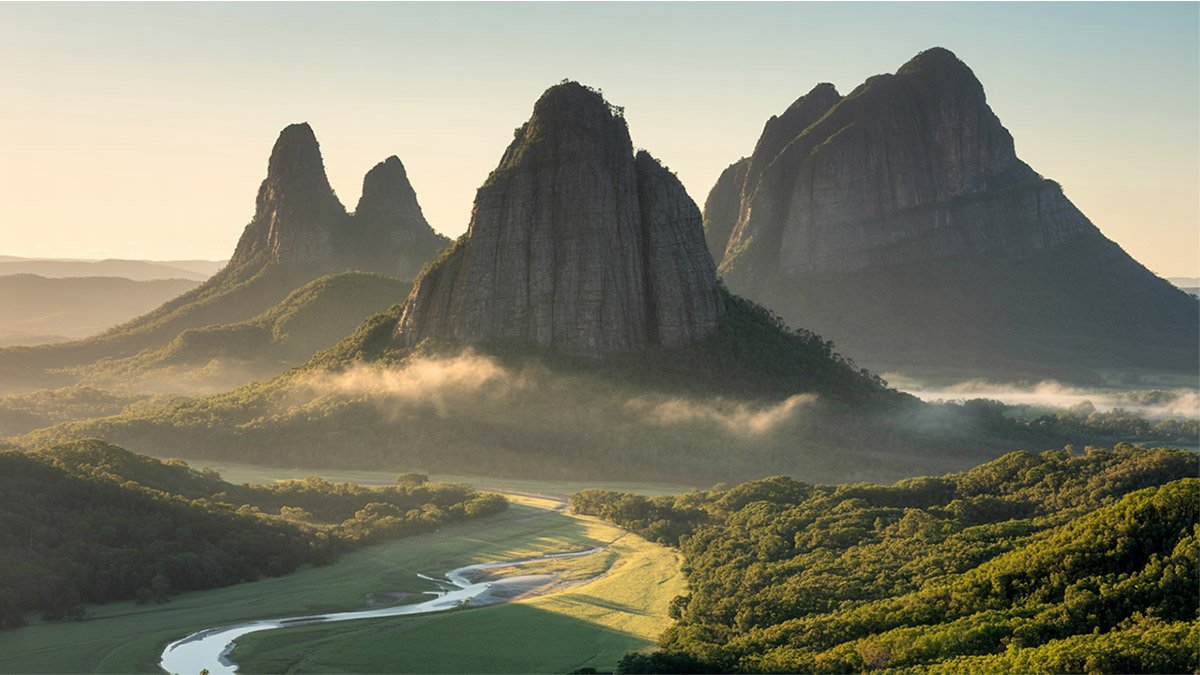
The region offers numerous hiking trails catering to different fitness levels and experience:
- Mount Ngungun Summit Walk – A relatively short (2.8 km return) but rewarding hike with spectacular 360-degree views of the surrounding mountains. This trail is ideal for beginners and families with older children.
- Mount Tibrogargan Circuit – A 3.2 km circuit around the base of this imposing mountain, offering beautiful forest scenery without the challenging climb.
- Mount Beerwah Summit Route – For experienced hikers only, this challenging route takes you to the highest peak in the range.
The Glass House Mountains hold deep significance for the local Gubbi Gubbi people, with each peak featuring in Aboriginal creation stories. Interpretive signs throughout the area share these cultural narratives, adding depth to your hiking experience.
Beyond these highlighted attractions, the Sunshine Coast also offers excellent day trip opportunities from Brisbane, including Australia Zoo (founded by Steve Irwin), the colorful Eumundi Markets, and the charming hinterland villages of Maleny and Montville with their artisan shops and stunning valley views.
Gold Coast Attractions
Overview of the Gold Coast
The Gold Coast presents a striking contrast to the Sunshine Coast with its vibrant, urban beach atmosphere. This coastal metropolis is characterized by its gleaming skyscrapers, bustling entertainment districts, and energetic vibe [SOURCE]. Stretching along 57 kilometers of coastline, the Gold Coast has transformed from a small beachside destination to Australia’s sixth-largest city while maintaining its appeal as a premier holiday spot.
What distinguishes the Gold Coast is its blend of natural beauty with urban excitement. Here, world-class beaches sit alongside shopping malls, theme parks, and nightlife venues, creating a destination that never sleeps. The region caters exceptionally well to families seeking entertainment, couples looking for vibrant dining and nightlife, and adventure enthusiasts ready to try everything from surfing to skydiving.
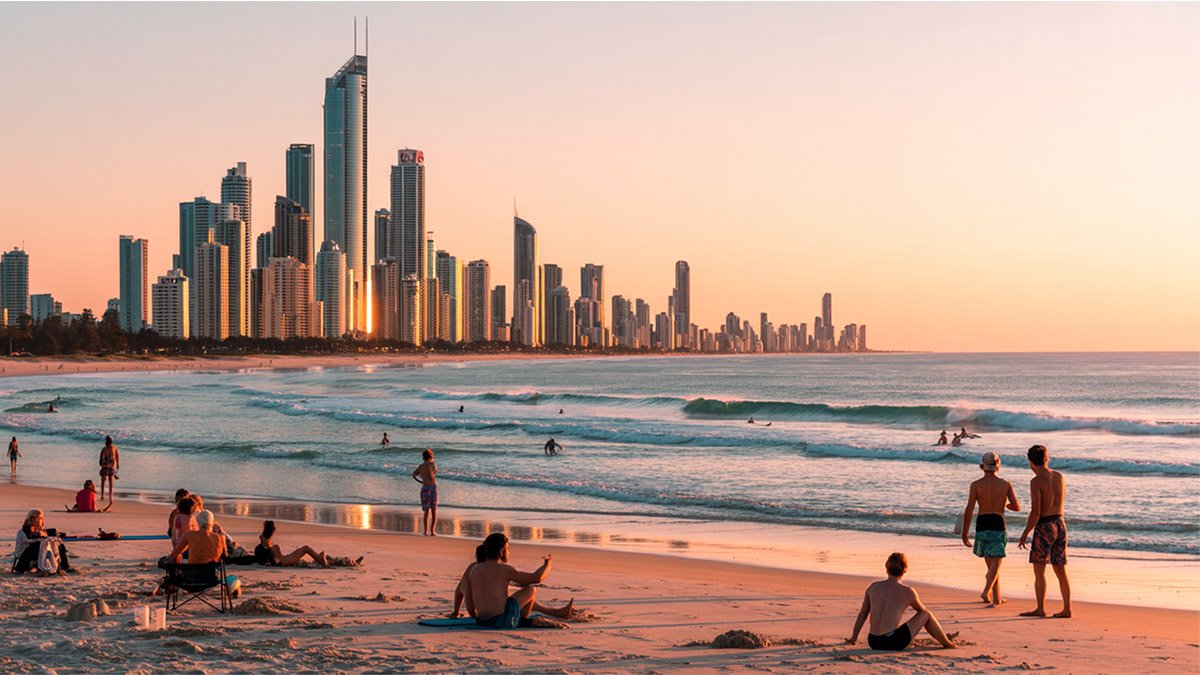
Currumbin Wildlife Sanctuary Review
Currumbin Wildlife Sanctuary stands as one of the Gold Coast’s most beloved family attractions. This heritage-listed wildlife park spans 27 hectares and has been delighting visitors since 1947 [SOURCE]. Unlike larger, more commercial wildlife parks, Currumbin maintains a focus on conservation and education while providing intimate animal experiences.
The sanctuary offers several standout experiences:
- Lorikeet Feeding – Twice daily, hundreds of rainbow lorikeets descend for feeding sessions, creating a colorful spectacle as they land on visitors’ arms and shoulders
- Koala Encounters – Opportunities to cuddle koalas and have your photo taken with these iconic Australian marsupials
- Wildlife Hospital – A working hospital where visitors can observe veterinarians treating injured native wildlife
- Aboriginal Cultural Performances – Showcasing traditional dances and didgeridoo playing
- Free-range Kangaroo Feeding – Interact with kangaroos and wallabies in an open grassland setting
The sanctuary’s TreeTop Challenge, featuring more than 80 challenges and 11 ziplines, adds an adventure component for older children and adults. Educational talks throughout the day provide insights into Australia’s unique wildlife, making Currumbin both entertaining and informative.
Lamington National Park Waterfalls
Lamington National Park, located in the Gold Coast hinterland, offers a cool, green retreat from the coastal heat. This World Heritage-listed rainforest boasts an extensive network of walking trails leading to spectacular waterfalls, ancient trees, and breathtaking lookouts [SOURCE]. The park’s elevation (up to 1,100 meters) creates a microclimate that supports diverse plant and animal life not found along the coast.
Notable waterfall walks in the park include:
- Morans Falls Track – A 4.4 km return walk leading to a stunning waterfall that cascades into a deep gorge
- Box Forest Circuit – A 10.9 km trail passing multiple waterfalls including Elabana Falls and Box Log Falls
- Twin Falls Circuit – A popular 4 km loop featuring two beautiful waterfalls and opportunities to swim in natural pools
Lamington National Park is divided into two sections: the Green Mountains (O’Reilly’s) and Binna Burra. Both offer accommodation options, from camping to luxury lodges, allowing visitors to extend their stay and fully immerse themselves in the rainforest experience.
The park is home to more than 180 bird species, including the rare Albert’s lyrebird and the colorful regent bowerbird. Early morning walks provide the best opportunities for birdwatching, while guided night walks reveal the park’s nocturnal creatures, including glowing fungi and glow worms.
Surfers Paradise Beach Guide
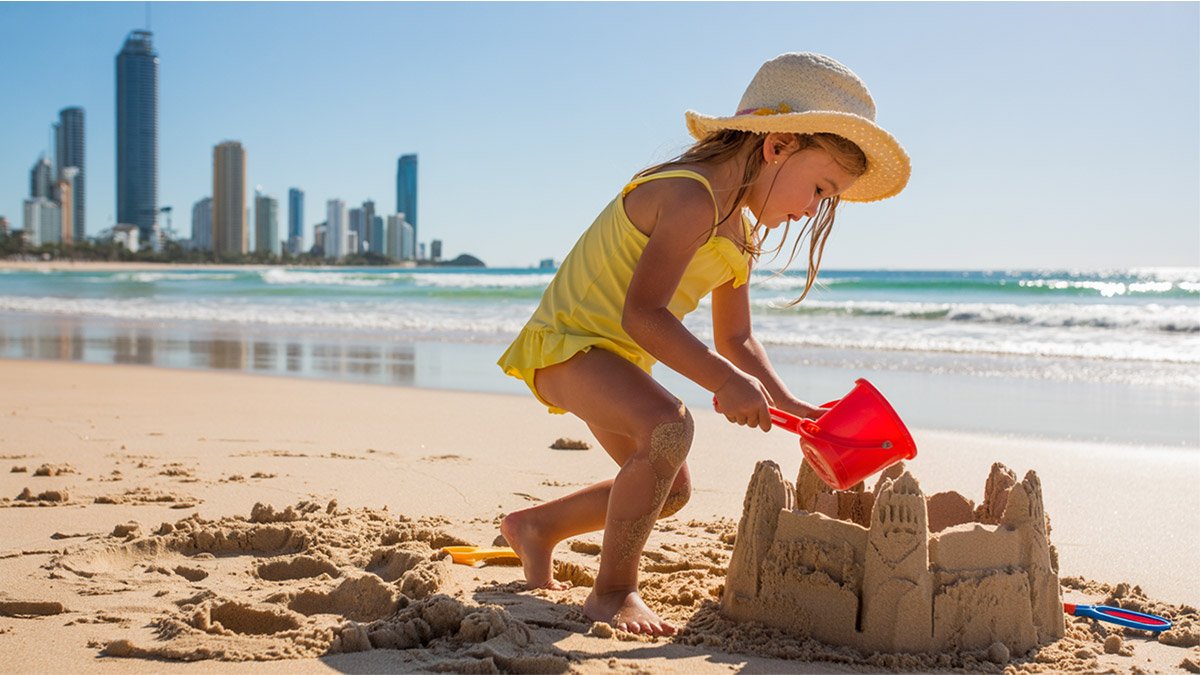
No Gold Coast visit is complete without experiencing Surfers Paradise Beach, the iconic heart of the region’s beach culture. This 3-kilometer stretch of golden sand represents the quintessential Australian beach scene, backed by the city’s dramatic skyline [SOURCE]. Despite being one of Australia’s most famous beaches, its size means you can usually find your own space to relax.
The beach is patrolled year-round by lifeguards, with swimming recommended between the red and yellow flags. The consistent surf breaks make it ideal for beginners learning to surf, with several surf schools offering lessons for all ages. Equipment rental is readily available for those wanting to try bodyboarding, stand-up paddleboarding, or jet skiing.
Beyond the sand, Surfers Paradise offers:
- Beachfront Markets – Operating Wednesday, Friday, and Sunday nights along the esplanade
- Cavill Avenue – The main shopping and dining strip running perpendicular to the beach
- SkyPoint Observation Deck – Located in the Q1 building, offering 360-degree views from 230 meters above sea level
- Ripley’s Believe It or Not! – A quirky museum of oddities perfect for families
When the sun sets, Surfers Paradise transforms into the Gold Coast’s nightlife capital, with numerous bars, clubs, and live music venues. For family-friendly evening entertainment, the area hosts street performers along the beachfront and regular fireworks displays during peak season.
The Gold Coast region is also home to stunning natural landscapes that rival some of Australia’s best known. From the beach, it’s easy to plan day trips to nearby attractions like Springbrook National Park with its glowworm caves and Natural Bridge formation.
Comparative Analysis: Sunshine Coast vs. Gold Coast
Atmosphere and Activities
The Sunshine Coast and Gold Coast offer distinctly different atmospheres, each catering to different types of travelers. Understanding these differences is crucial for planning the right Queensland coastal experience for your preferences.
The Sunshine Coast excels in providing a relaxed, nature-focused environment. Its beaches are generally less crowded, and the pace of life is noticeably slower. Towns like Noosa and Mooloolaba offer sophisticated dining and shopping but maintain a village-like atmosphere. Activities tend to center around natural experiences—coastal walks, national park exploration, and wildlife encounters in natural settings.
In contrast, the Gold Coast embraces its urban energy with high-rise buildings, bustling shopping centers, and a vibrant entertainment scene. The region never truly sleeps, offering activities from dawn surf sessions to late-night dining and clubbing. The Gold Coast tends to attract those seeking excitement, entertainment, and a more cosmopolitan beach experience.
Family-Friendly Attractions
Both coasts offer excellent family experiences, but with different focuses that may appeal to different age groups and interests.
The Sunshine Coast provides family attractions that generally connect children with nature and animals. Key family destinations include:
- Australia Zoo – Steve Irwin’s legacy featuring close-up wildlife encounters
- SEA LIFE Sunshine Coast – An aquarium showcasing local marine life
- Aussie World – A smaller, more manageable theme park ideal for younger children
- Ginger Factory – Offering factory tours, rides, and honey tastings
The family beaches of the Sunshine Coast, particularly Kings Beach at Caloundra and Mooloolaba Beach, feature calm waters and excellent facilities, making them ideal for families with young children.
The Gold Coast is known for its larger-scale family entertainment options:
- Theme Parks – Warner Bros. Movie World, Dreamworld, and Sea World offer thrill rides and shows
- WhiteWater World and Wet’n’Wild – Water parks perfect for hot days
- Currumbin Wildlife Sanctuary – More intimate animal encounters
- Infinity Attraction and Ripley’s Believe It or Not! – Indoor entertainment options
The Gold Coast’s theme parks typically appeal to families with older children and teenagers seeking more adrenaline-pumping experiences. However, all major parks include areas designed for younger visitors as well.
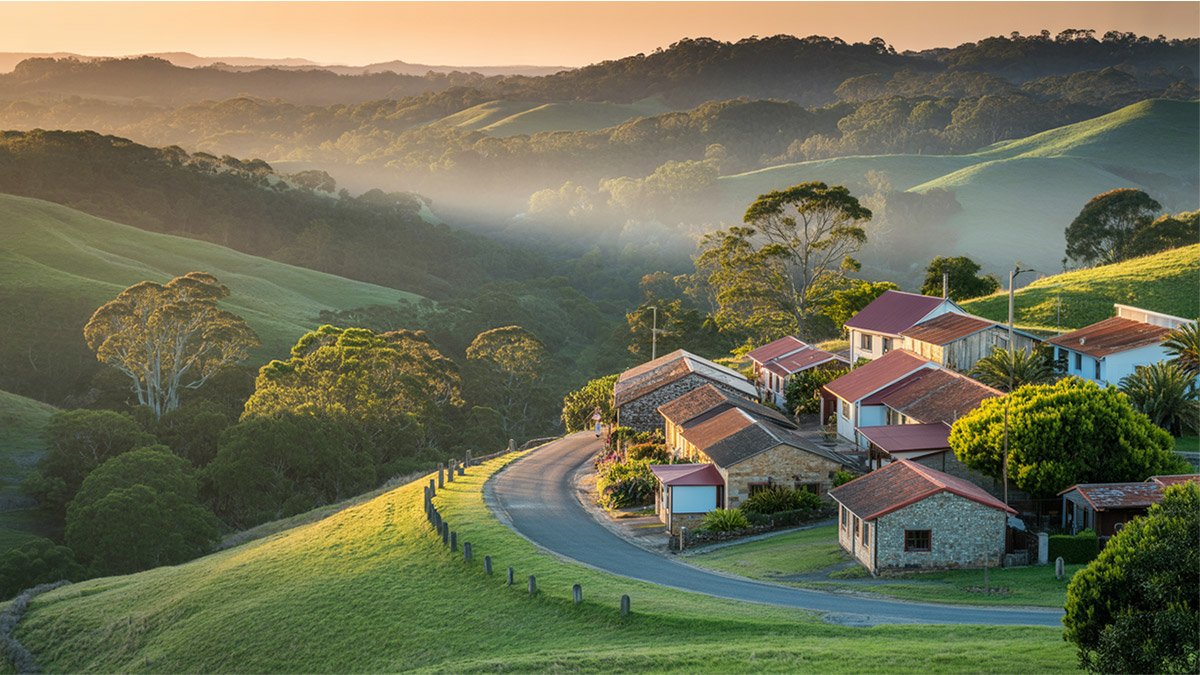
Nature vs. Urban Appeal
The natural landscapes of both regions offer distinct appeals worth considering when planning your Queensland coastal holiday.
The Sunshine Coast showcases nature in a more pristine state. Its national parks, including Noosa National Park and the Glass House Mountains, remain relatively undeveloped, offering authentic wilderness experiences. The hinterland villages provide charming bases for exploring rainforests, waterfalls, and scenic lookouts. The coastline features more headlands and protected bays, creating diverse beach experiences from the sheltered waters of Mooloolaba to the surf breaks of Coolum.
The Gold Coast integrates natural beauty with urban development. Its 57 kilometers of beaches run alongside high-rise buildings in central areas, while areas like Burleigh Heads offer a more natural coastal experience. The hinterland areas, including Lamington and Springbrook National Parks, provide accessible rainforest experiences with well-maintained trails and facilities. The extensive canal system offers waterfront living and water-based activities in a created environment.
For travelers seeking a scenic coastal experience, both regions deliver but with different aesthetics—the Sunshine Coast with a more natural coastline and the Gold Coast with its dramatic juxtaposition of beaches and skyline.
Practical Tips and Recommendations
Best Visiting Times
Timing your visit to Queensland’s coastal regions can significantly impact your experience. Both the Sunshine Coast and Gold Coast enjoy subtropical climates, but there are optimal periods for visiting each area [SOURCE].
For the Sunshine Coast, the best visiting times are:
- September to November (Spring) – Warm days (20-26°C), mild nights, and lower humidity make this perfect for outdoor activities
- April to June (Autumn) – Similar comfortable temperatures with fewer crowds after the Easter holiday period
Summer (December to February) brings warmer temperatures (25-30°C) ideal for beach activities but also higher humidity and occasional afternoon thunderstorms. This is also the busiest and most expensive period, especially during the Australian school holidays.
For the Gold Coast, optimal visiting periods include:
- September to November – Pleasant temperatures and typically lower rainfall
- March to May – Warm ocean temperatures and fewer crowds after the summer peak
The Gold Coast tends to be busy year-round but experiences significant peaks during school holiday periods (particularly December-January and June-July) and special events like the Gold Coast 500 Supercars race and Schoolies Week (November).
Both regions can experience rainfall throughout the year, with February-March typically seeing the highest precipitation. If hiking in the hinterland areas is a priority, the cooler, drier winter months (June-August) offer comfortable conditions and clearer views.
Accommodation Suggestions
The accommodation options on both coasts cater to different travel styles and budgets.
On the Sunshine Coast, consider:
- Noosa – Luxury resorts and apartments along Hastings Street for those seeking upscale experiences close to dining and beaches
- Mooloolaba and Alexandra Headland – Family-friendly apartment accommodations with excellent beach access
- Maleny and Montville – Boutique B&Bs and cottages in the hinterland for romantic getaways
- Coolum Beach – More affordable apartment options with great surf beaches
For the Gold Coast, options include:
- Surfers Paradise – High-rise apartment accommodations and hotels in the heart of the action
- Broadbeach – Upscale apartments and hotels near shopping and dining, slightly quieter than Surfers Paradise
- Burleigh Heads – Boutique accommodations in a more laid-back beachside suburb
- Currumbin and Coolangatta – Family-friendly options in less developed areas
- O’Reilly’s Rainforest Retreat or Binna Burra Lodge – Wilderness lodges in Lamington National Park
For longer stays, both regions offer holiday house rentals that can be more economical for families or groups. Booking well in advance is essential for peak periods, especially for premium locations like beachfront properties in Noosa or apartments with ocean views in Surfers Paradise.
Transportation and Nearby Attractions
Getting around and exploring beyond your base location requires some planning on both coasts.
For the Sunshine Coast:
- Car rental is highly recommended as public transport, while available, is limited in frequency and reach
- Sunshine Coast Airport at Maroochydore offers direct flights from major Australian cities
- Local buses connect major towns but service can be infrequent
Nearby attractions worth including in your Sunshine Coast itinerary:
- Mary Cairncross Scenic Reserve – Rainforest walks with stunning Glass House Mountains views
- Australia Zoo – Located at Beerwah, approximately 30 minutes from Caloundra
- Eumundi Markets – Australia’s premier artisan market (Wednesday and Saturday mornings)
- Fraser Island – The world’s largest sand island, accessible by day tour from Noosa
For the Gold Coast:
- G:link light rail connects Broadbeach to Surfers Paradise and beyond
- Bus network is comprehensive throughout the coastal strip
- Gold Coast Airport at Coolangatta offers domestic and some international flights
- Car rental is recommended for exploring the hinterland
Nearby attractions worth including in your Gold Coast itinerary:
- Mount Tamborine – Artisan shops, wineries, and rainforest walks
- Springbrook National Park – Natural Bridge and glow worm caves
- Tweed Heads – Cross the border into NSW for different beaches and dining
- Byron Bay – Australia’s easternmost point, approximately 1 hour south with its own unique attractions
Insider Tips
Make the most of your Queensland coastal holiday with these local insights:
For the Sunshine Coast:
- Arrive at Noosa National Park before 8 am to secure parking and enjoy the coastal walk before the heat of the day [SOURCE]
- Visit Eumundi Markets early to avoid crowds, or come in the last hour for potential bargains
- Use Mooloolaba as a central base if you plan to explore the entire region, as it offers a good balance of amenities and location
- Check the tides before planning beach activities, as some beaches like Noosa’s Main Beach become quite narrow at high tide
For the Gold Coast:
- Purchase theme park multi-passes for significant savings if visiting multiple attractions
- Visit Surfers Paradise Beach in the early morning for the best experience before crowds arrive
- Explore Burleigh Heads National Park for a quieter beach and walking experience
- Stay in Broadbeach for a more relaxed atmosphere while maintaining easy access to Surfers Paradise via the light rail
- Check for special events that might affect accommodation prices and availability
For both regions, remember that beach safety is paramount. Always swim between the red and yellow flags where lifeguards patrol, and be aware of changing conditions, particularly rip currents which can be dangerous even for strong swimmers.
If you’re interested in experiencing more of Australia’s east coast, consider how these regions can connect to other destinations like Sydney’s iconic attractions to create a more comprehensive Australian journey.
Frequently Asked Questions about Sunshine Coast & Gold Coast Highlights
What is the best time to visit the Sunshine Coast and Gold Coast?
The ideal time to visit both the Sunshine Coast and Gold Coast is during the spring (September to November) and autumn (April to June). These seasons offer mild temperatures (20-26°C), lower humidity, and fewer crowds, making it perfect for outdoor activities like hiking in Noosa National Park or exploring Surfers Paradise Beach. Summer can be hot and busy, while winter brings cooler but still pleasant weather, particularly for hinterland experiences like Lamington National Park waterfalls.
How do I get around the Sunshine Coast and Gold Coast?
For the Sunshine Coast, renting a car is recommended, as public transport options are limited. You can easily access key attractions like Noosa and the Glass House Mountains by car. On the Gold Coast, public transport is more extensive, with the G:link light rail connecting major areas. Renting a car is still useful for exploring the hinterland and beaches outside of the main city center. Both regions have well-connected airports for international and domestic flights.
Is the Noosa National Park Coastal Walk suitable for all fitness levels?
The Noosa National Park Coastal Walk is accessible to most fitness levels, as it offers both paved and natural sections. The path stretches 5.4 km each way, with some challenging segments but plenty of easy, scenic stretches. Key points like Dolphin Point and Alexandria Bay provide excellent wildlife viewing and stunning coastal views. The walk is wheelchair accessible until Dolphin Point, making it suitable for many visitors. Starting early ensures better parking and a chance to spot more wildlife.
What family-friendly attractions are there on the Gold Coast?
The Gold Coast is packed with family-friendly attractions. Visit the Currumbin Wildlife Sanctuary for intimate animal encounters or head to the theme parks such as Warner Bros. Movie World and Dreamworld. These parks offer thrilling rides, live shows, and experiences for all ages. For something more laid-back, explore the beaches or take a family-friendly hike in Burleigh Heads National Park, where kids can enjoy both nature and adventure.
How do the Sunshine Coast and Gold Coast compare in terms of natural beauty?
The Sunshine Coast offers a more relaxed, nature-focused experience, with pristine beaches, national parks like Noosa National Park, and the scenic Glass House Mountains. The region’s natural beauty is less commercialized, providing tranquil settings for outdoor adventures. In contrast, the Gold Coast combines stunning natural landscapes with urban development. While its beaches are iconic, the region also boasts lush hinterland areas like Lamington National Park, where waterfalls and rainforests create a perfect escape from the city.
Conclusion
This sunshine coast travel guide has explored the distinct characters and attractions of Queensland’s two premier coastal destinations. The Sunshine Coast offers a relaxed, nature-focused experience with highlights including the spectacular Noosa National Park Coastal Walk and the dramatic Glass House Mountains hiking trails. Its charm lies in its laid-back atmosphere, pristine natural environments, and sophisticated yet unpretentious coastal towns.
In contrast, the Gold Coast delivers a more energetic, entertainment-rich experience centered around its famous beaches and urban amenities. From the family-friendly Currumbin Wildlife Sanctuary to the iconic Surfers Paradise Beach and the lush rainforests and waterfalls of Lamington National Park, the Gold Coast combines natural beauty with vibrant urban experiences.
The ideal choice between these two remarkable destinations depends entirely on your travel preferences:
- Choose the Sunshine Coast if you value tranquility, natural landscapes, and a more relaxed pace
- Opt for the Gold Coast if you seek entertainment options, nightlife, and a more dynamic atmosphere
Many visitors to Queensland choose to experience both regions, perhaps starting with the excitement of the Gold Coast before unwinding on the Sunshine Coast, or vice versa. With just 200 kilometers separating them, it’s entirely possible to enjoy the best of both worlds in a single holiday.
Whichever coast you choose, Queensland’s combination of stunning beaches, lush hinterlands, and welcoming climate ensures an unforgettable Australian coastal experience. Plan your visit during the optimal seasons, secure accommodations that match your travel style, and prepare to discover why these coastal regions rank among Australia’s most beloved holiday destinations.
For more stunning Australian travel inspiration, be sure to visit Pathfinders Travel on YouTube to watch their spectacular 4K travel documentaries showcasing the wonders of Australia and beyond.

